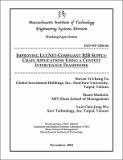Improving UccNet-Compliant B2B Supply-Chain Applications Using a Context Interchange Framework
Author(s)
Tu, Steven Yi-Cheng; Madnick, Stuart E.; Wu, Luis Chin-Jung
Downloadesd-wp-2004-06.pdf (369.0Kb)
Metadata
Show full item recordAbstract
UccNet (http://knowledgebase.uccnet.org) is a globally centralized B2B electronic data platform for storing trading product item information and hosted by the non-profit international standardization institute EAN-UCC. It is an emerging B2B data communication standard for the retail industry with significant potential impact. Many US retailers are requesting their international suppliers for compulsory subscription by the year-end of either 2004 or 2005 and many major IT software providers and consulting firms specialized in supply chain management are preparing packaged services/solutions for this imminent demand.
In light of the increasing importance of UccNet on both the technology and application sides, this paper attempts to advance the following argument: Though UccNet establishes an architectural framework to resolve the many-to-many connectivity issue and data synchronization issue through a centralized product database and a uniform numbering system (i.e., Global Trade Item Numbering), there are context discrepancy issues remaining to be addressed. We show with a real case study that context discrepancy is inherent in the international trading applications where UccNet is intended to be used. Naturally, international trading partners tend to define and describe product item information differently. That difference, either due to the culture or the geographical location, is not considered in the original design of UccNet. As an example, the attribute "width" contained in the database schema of UccNet would be filled by a China-based supplier in 'meter' and yet be interpreted as 'feet' by the US retail buyer.
We show how the Context Interchange Framework, operating under the rationale of local autonomy and speaking to the resolution of context mediation issue, can be nicely incorporated into the existing UccNet framework to constitute theoretically a more complete technical solution and practically a more useful B2B supply chain business solution.
Date issued
2004-11Publisher
Massachusetts Institute of Technology. Engineering Systems Division
Series/Report no.
ESD Working Papers;ESD-WP-2004-06